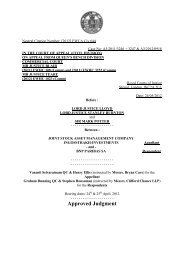Megaprojects - KPMG
Megaprojects - KPMG
Megaprojects - KPMG
You also want an ePaper? Increase the reach of your titles
YUMPU automatically turns print PDFs into web optimized ePapers that Google loves.
Enrique Fuentes (EF): Based on your<br />
experience developing megaprojects<br />
in different parts of the world, what are<br />
some of the biggest challenges you face<br />
as developers<br />
Carlos Bosch (CB): Probably the biggest<br />
challenge that all megaprojects face is in<br />
dealing with the implications of a very long<br />
timeline. <strong>Megaprojects</strong> sometimes take<br />
a decade or more to move from design<br />
to handover, which can create significant<br />
challenges related to both the escalation<br />
of costs and the potential for technology or<br />
design elements to become obsolete before<br />
the project is even completed. Hospital<br />
technology, for example, seems to change<br />
almost every year which makes designing,<br />
building and delivering a turnkey mega-hospital<br />
project rather difficult if those parameters and<br />
the tools to solve them have not been taken<br />
into account from the beginning.<br />
Carlos Hermanny (CH): On top of this, many<br />
megaproject developers face significant<br />
social and environmental risks that can easily<br />
cause projects to be delayed or stalled.<br />
In effect, this has a direct impact on the<br />
financing of the project because it is very<br />
difficult to secure funding when some of<br />
the risks are unknown. Aligning the vision<br />
of multiple subcontractors can also create<br />
unique challenges as each partner brings<br />
a different culture and approach to their<br />
part of the job. In our experience, a lack of<br />
alignment between partners can often lead<br />
to further time delays and potential overruns<br />
as decisions are debated and consensus is<br />
laboriously achieved on an issue by issue<br />
basis.<br />
I P Rao (IR): I would agree with everything<br />
already said and add two more challenges.<br />
The first is finding and securing experienced<br />
professionals with the right capabilities<br />
and skills to successfully deliver on such a<br />
large and complex project. In almost every<br />
country and region, the supply of experienced<br />
professionals who understand the complexity<br />
of megaproject development is tight. Another<br />
challenge that I would mention relates to<br />
stakeholder management. In India, there is no<br />
‘single window’ for megaprojects and so each<br />
government department must be managed<br />
individually. For the Delhi International Airport,<br />
this meant that we had to work through<br />
53 different government departments. That<br />
can make a project very complex and risky.<br />
EF: In my experience, megaproject developers<br />
often have hundreds of subcontractors<br />
partnering on the same project. Do you<br />
have an approach to contract structuring that<br />
lets you better apportion construction risk<br />
IR: Our airport project involved more than 250<br />
subcontractors and three main contractors,<br />
so apportioning the construction risk was<br />
a very difficult and complex job. The reality<br />
is that it is very difficult for many of our<br />
subcontractors to take on the construction<br />
risk. But it all depends on how the package of<br />
work is tendered. If the risks are well known<br />
and everything is stated up front, then the<br />
costs will be lower because the risks are<br />
defined and understood. In other cases, the<br />
cost of construction risk is loaded into the<br />
contract which can push up the price overall.<br />
CH: I think it really all depends on how the<br />
client or project owner wants to structure<br />
the project. In some cases, the client wants<br />
to split the project into multiple packages<br />
which makes apportioning of risk much<br />
easier because the size of that risk is more<br />
easily understood and delegated. But if they<br />
are looking for a single consortium that is<br />
responsible for all aspects of the project, we<br />
have often found that we need to split the<br />
job into different inter-related consortiums<br />
that take responsibility for their part of the<br />
project, yet work together to deliver a single<br />
final project to the client.<br />
CB: I think the key that underlies both<br />
of these views is the need to create a<br />
joint collaborative environment amongst<br />
40 | INSIGHT | <strong>Megaprojects</strong>





![[2012] UKUT 399 (TCC)](https://img.yumpu.com/51352289/1/184x260/2012-ukut-399-tcc.jpg?quality=85)





![Neutral Citation Number: [2009] EWHC 3198 (Ch) Case No: CH ...](https://img.yumpu.com/50120201/1/184x260/neutral-citation-number-2009-ewhc-3198-ch-case-no-ch-.jpg?quality=85)





